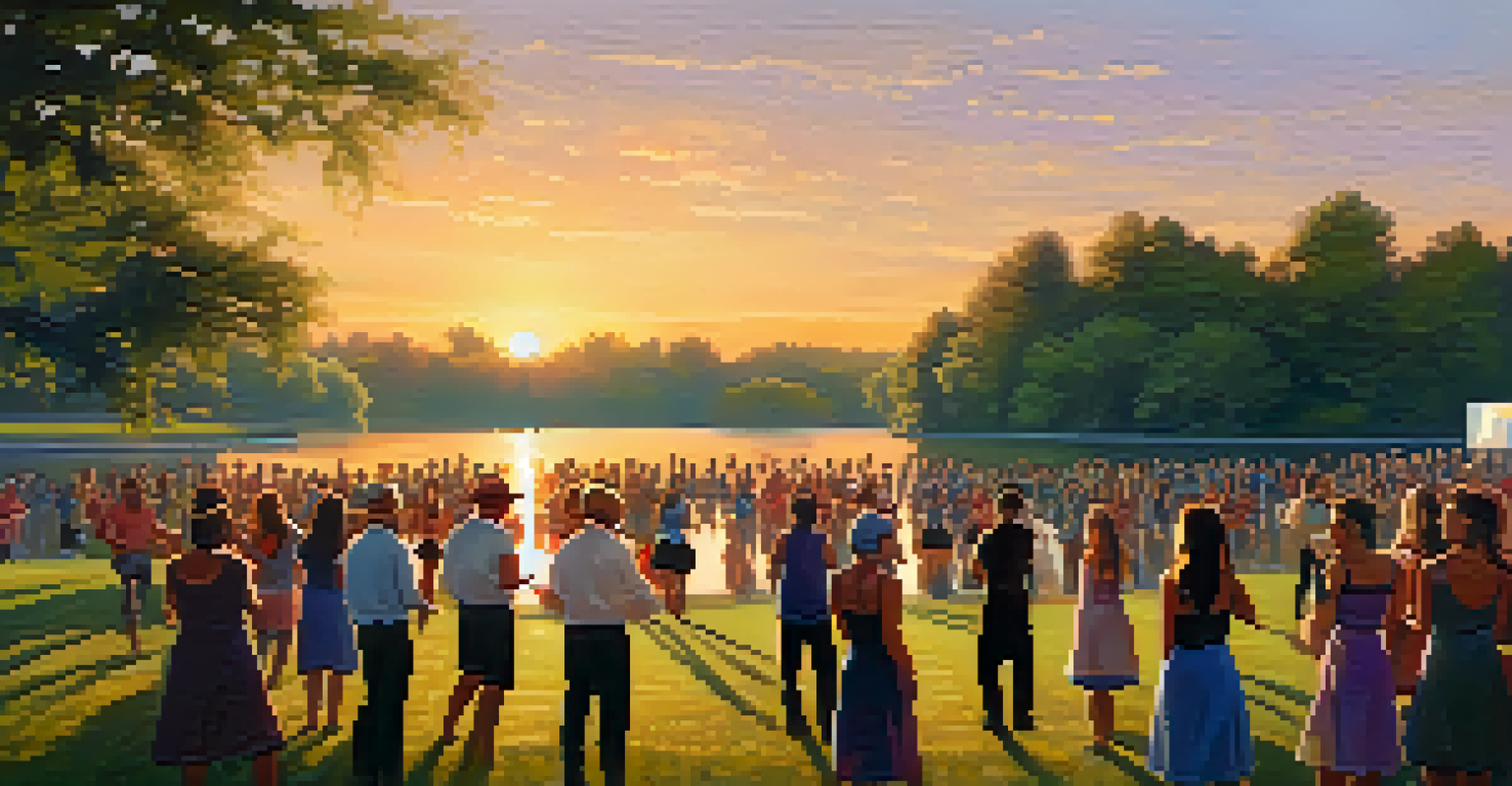Dance as a Medium for Promoting Environmental Awareness

The Intersection of Dance and Environmentalism
Dance is not just an art form; it’s a powerful medium for storytelling. By incorporating themes of nature and environmental issues, dancers can convey messages that resonate deeply with audiences. This intersection can spark conversations about sustainability and ecological responsibility.
Dance is the hidden language of the soul.
For instance, a dance piece that mimics the movement of ocean waves can evoke feelings of tranquility while highlighting the beauty of marine life. Such performances can remind viewers of the delicate balance within ecosystems, encouraging them to think critically about their own impact on the environment.
Moreover, dance can create a visceral connection to environmental issues, often invoking emotions that statistics alone cannot. When people feel something on a personal level, they are more likely to take action, making dance an effective tool for promoting environmental awareness.
Historical Context: Dance as a Form of Protest
Throughout history, dance has been used as a form of protest and social change. From the civil rights movement to contemporary climate activism, dancers have used their bodies to express dissent and inspire change. This rich history underscores the potential of dance as a platform for environmental advocacy.

For example, the 'Dancing for the Earth' initiative encourages performers to engage with local environmental issues through choreographed movements. These performances often take place in natural settings, further emphasizing the relationship between art and the environment.
Dance as a Tool for Environmentalism
Dance can convey powerful messages about environmental issues, inspiring audiences to reflect on their ecological impact.
By invoking this historical context, we can see how dance has always been more than entertainment; it’s a way to unite people around shared causes and inspire collective action, particularly in the realm of environmentalism.
Choreography That Speaks to Ecological Issues
Choreographers play a crucial role in shaping how environmental messages are communicated through dance. By crafting routines that symbolize ecological challenges—like deforestation or climate change—choreographers can create powerful narratives that resonate with audiences. Each movement can serve as a metaphor for a larger issue, making the message more accessible.
We won't have a society if we destroy the environment.
For instance, a dance depicting the life cycle of a tree can illustrate the importance of forests in combating climate change. Each part of the choreography can represent different stages, evoking a deeper understanding of ecological interdependence.
In this way, choreography becomes a language of its own, capable of conveying complex environmental issues in a manner that is both engaging and thought-provoking. This artistic expression can leave a lasting impact on the audience, inspiring them to reflect on their own relationship with the environment.
Community Engagement Through Dance Events
Dance events focused on environmental awareness can foster community engagement and activism. Workshops, flash mobs, and performances can bring people together to celebrate nature while promoting sustainable practices. These gatherings often create a sense of belonging and shared purpose.
For example, community dance festivals can highlight local environmental issues, encouraging participants to take part in discussions and activities that promote sustainability. By merging art and activism, these events can educate audiences on how to make a positive impact.
Community Engagement Through Dance
Dance events can unite communities around environmental causes, fostering a sense of belonging while promoting sustainability.
Additionally, involving local artists and activists in these events can strengthen community ties and amplify the message. When people see their peers participating, they’re more likely to engage and take action, creating a ripple effect of environmental consciousness.
Collaboration Between Artists and Environmentalists
Collaboration is key in merging dance with environmental activism. When artists team up with environmentalists, they can create innovative projects that highlight pressing ecological issues. These partnerships can amplify messages and reach broader audiences, making a more significant impact.
For example, a collaborative project might involve dancers performing at a local conservation site, drawing attention to its preservation. This not only showcases the beauty of the location but also educates the audience on why it needs protection.
Such collaborations can also lead to the creation of unique art forms that blend movement with environmental science, further enriching the dialogue around sustainability. By working together, artists and environmental advocates can inspire individuals to consider their roles in the health of our planet.
The Role of Technology in Dance and Awareness
In today’s digital age, technology plays a significant role in how dance can promote environmental awareness. Social media platforms allow artists to share their performances with a global audience, spreading their messages far and wide. This increased visibility can lead to greater discussions around environmental issues.
For instance, dance challenges on platforms like TikTok can inspire participants to create their routines centered on environmental themes. This not only engages a younger audience but also encourages them to think critically about their actions while having fun.
Collaboration Enhances Impact
Partnerships between artists and environmentalists create innovative projects that effectively highlight and address ecological challenges.
Moreover, virtual performances can reach audiences who may not have access to live events, making dance a more inclusive medium for environmental advocacy. By harnessing technology, dancers can create a worldwide movement that inspires change and raises awareness about ecological issues.
Inspiring Future Generations Through Dance
Educating the next generation about environmental issues through dance can be a powerful approach. By integrating dance into school curriculums or community programs, we can teach children about sustainability in an engaging way. This hands-on experience allows them to express their thoughts and feelings about the environment creatively.
For example, schools that incorporate dance into environmental education can encourage students to create their own pieces based on nature, fostering a connection with the world around them. This not only nurtures creativity but also instills a sense of responsibility toward the planet.

By inspiring young dancers to become advocates for the environment, we can cultivate a culture of sustainability that resonates for generations to come. The joy of movement combined with a sense of purpose can empower youth to take action and make a difference.